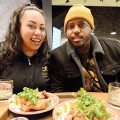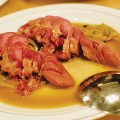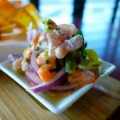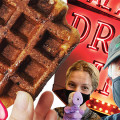As is the case for many who work in the food and drink industry, Monday is typically the day that chef Josh Hanoka gets to take a breather. It is the one day of the week when his Willow Glen restaurant Braise isn’t open.
Today, however, he and Braise co-chef Anthony Jimenez are hosting a private party of wine industry folks. So they each have a bit of prep to do before they can put down their knives and talk shop.
Taking a rare moment to actually sit at a table on the sidewalk patio of their Lincoln Avenue storefront, Hanoka says he often avoids hanging out with his partner outside of business hours.
It’s not because the two don’t get along. Rather, Hanoka says, it is hard to avoid bringing the kitchen with them wherever they go.
“This job takes a lot from you,” he says. “It’s all nights, weekends and holidays. Anytime people get together, that’s when you’re working.”
Jimenez nods in agreement: “It’s an at-all-costs kind of thing.”
But as the morning gives way to a warm, breezy afternoon, the two seem relaxed, and Hanoka says he is enjoying the chance to revel in just how far he and Jimenez have come.
This is more than a quiet celebration of a well-earned achievement; it is also a demonstration of the restraint Hanoka and Jimenez have learned to exercise over the course of their careers. After more than 20 years of working in restaurants and more than a decade of calling the shots in the kitchen, both men know better than to cheer too loudly for themselves.
Even after the success Hanoka has seen with his former sandwich shop—Bray at the San Pedro Square Market—and with the downtown drinking establishment Cinebar, where he is a co-owner, he knows that things can, and often do, go awry in this business. Jimenez knows as well. Opening Braise was a challenge, with plenty of unforeseen obstacles.
First there were issues with financing. The pair celebrated landing a loan twice before they actually secured funding. “We had gotten the loan—in writing—and everything was good, and then the bank would call,” Hanoka remembers.
Then there were hiccups in the permitting process. Though they’d planned to open in the middle of 2017, changes made to the building by a previous tenant had to be fixed before they could start serving customers. “There were a lot of sleepless nights and a lot of anxiety,” Hanoka says.
And then there was the fire, set off by a faulty power box attached to the back of the building. Hanoka was doubly lucky: He was near enough to hear the crackling and buzzing—which alerted him to the blaze—and fortunate that the fire extinguisher he reached for in that moment didn’t act as a conductor: it was not intended to put out electrical fires.
“The fire chief was like, ‘Thank you for doing that, but you should be dead, dead, dead.’ And I was like, ‘Did you just say dead three times?’”
The fire forced Braise to close for a few months last summer, and while things are going well now, both men still wonder about the momentum they lost.
DIFFERENT STROKES
Hanoka and Jimenez have faced plenty of hurdles on the road to making Braise a reality. But their path to success mirrors the paths of so many up-and-coming cooks and chefs currently working their way through the kitchens of Silicon Valley.
It is a business in which there is no clearly defined career trajectory. Hanoka earned an associate’s degree from Johnson & Wales University’s culinary school in Denver, while Jimenez learned his craft at the soon-to-be-shuttered International Culinary Center campus in Campbell.
Some manage to climb the ranks within a single organization, while others bounce around from gig to gig, picking up as much as they can along the way and parlaying each job change into a higher title.
“In this industry, you can start as a dishwasher and become the chef of a restaurant,” Hanoka says.
That’s what Marshall Reid did.
Reid, who spent his 20s working odd jobs and playing music in a touring band, got his first job in a kitchen at 30 years old. He literally asked a former high school classmate if he could wash dishes for him.
Matt Close, who got his own start as a dishwasher, gave Reid a food prep job instead—at Firehouse No. 1 on San Pedro Street in downtown San Jose. Not long after, Reid found himself working as a line cook. He didn’t know the first thing about working in a professional kitchen.
From the Firehouse, Reid moved on to Cafe Stritch, where he learned from that restaurant’s founding chef, David Ramsey, who now runs the kitchen at LVL Up in Campbell. After a stint at Stritch, he was off to Morton’s Steakhouse and then Alexander’s Steakhouse, where he worked his way up to a lead cook.
A Facebook message to the chef of Naschmarkt Restaurant led to an opportunity at the Viennese restaurant in Campbell. He stayed only a few months before jumping ship in the hopes of starting a new restaurant in Redwood City with a former Alexander’s colleague. The project fizzled quickly and Reid struck out on his own, hosting his first pop-up kitchen at the recently shuttered Social Policy, which led to a job running the kitchen there for a time. He left about a year ago to consult and run pop-up kitchens. He hopes to open his own Mexican-inspired restaurant later this year.
“I don’t think there is such a thing as a normal progression,” says Reid, who is now 37. “Everybody takes such different paths to get where they are. You will work with people who went to a fancy culinary school and you haven’t. Somehow you end up on the same track.”
Hanoka and Jimenez—who are both around Reid’s age—wonder sometimes if they would still be in the same place without their official training. They’re certainly glad to have it. Hanoka says the business and bookkeeping he picked up at Johnson & Wales has been invaluable. However, they both agree there is no substitute for hard work and learning on the job.
“We went the culinary school route,” Hanoka says, “and I struggle to hire culinary students. To be honest, I always feel like they kind of have a big head.”
NICHE MARKETING
Reality TV portrays professional kitchens as pressure cookers boiling over with ego. On programs like Hell’s Kitchen and Iron Chef, only the strong survive, while the rest are sent packing. This shapes the popular imagination of what it means to be a working chef: Either you win big or you go home.
But there is more than one way to make a career out of cooking, and some of the most stable kitchen gigs in Silicon Valley are a part of our region’s massive tech sector.
“A lot of people assume a kitchen runs on aggression,” says Wendy Neff, who works as a superfood chef for one of the largest tech companies in the valley. “There’s this idea that a chef is supposed to be someone who is really aggressive and intense. That the world of food is so strong and competitive and angry. I think it’s really damaging.”
Neff may be particularly tuned into the most damaging stereotypes about chefs because she makes food that is meant to reverse damage.
“Food can literally help someone work through a time in which their health is not at its best,” she says, explaining what she means when she talks about superfood. “Food can literally help someone heal from an illness. Food can literally support the immune system.”
In her role, Neff craft recipes from nutrient-rich, non-processed and often raw foods, with a focus on sustainability and seasonality. It is a highly specialized position, which she says has helped her raise her profile in a crowded field.
Neff got her start at Good Karma Artisan Ales & Café. Working at a vegan restaurant piqued her interest in cooking healthy, and that’s when she decided to go to school for holistic nutrition. In school she learned how to cook for those with special dietary restrictions and allergies—like those with a gluten sensitivity—while sacrificing as little flavor as possible. Some of her specialties include gluten-free breads and a marinated, thinly sliced beet with the texture and taste of smoked salmon. When paired with a non-dairy cream cheese, the combo allows vegans with celiac disease to enjoy flavors they would otherwise miss out on.
“For me, carving out a niche is what made me really grow,” Neff says. “Making things that no one else can make—that’s how you stand out.”
MIX & MATCH
Hanoka and Jimenez know how to grab the public’s attention. One of Braise’s signature dishes is the head-turning peanut butter, jelly and bone marrow sandwich. It’s the kind of dish that gets diners talking and builds a buzz—but it also works. The savory, rich marrow harmonizes with the warm and familiar salty-sweet of the peanut butter, while a freshly pressed fruit jam lends a tangy pop.
But the PB&J with marrow is but one item on a creative, well-rounded menu that incorporates New American, French, Italian, Mexican and Asian influences and features plenty of fresh vegetables alongside unique proteins.
Their green papaya salad is made from shredded strings of young, unripe papaya and tossed with thinly sliced jalepeño, peanuts, a garlic-citrus dressing, cilantro and ginger.
Braise’s main dishes include a hamburger and a New York steak, as well as a soulful, sweet-and-savory fried chicken dish along with a whole roasted fish which is served with the head still attached and painted in a lemon- and caper-infused brown butter sauce.
After the main course section of the menu and before the desserts, there are three “Braised” dishes to choose from—pork cheek adobo tacos, mushroom cannelloni and the standout lamb tongue pastrami.
Reading the menu alongside Hanoka and Jimenez’s resumes, it is clear that they are incorporating pieces of everything they have learned along the way.
Both men attended Leland High School in San Jose and plotted different routes into professional kitchens. For Hanoka, a rambunctious youth led him to splitting his time between Leland and the Central County Occupational Center, where he discovered his love of cooking. Jimenez was exposed to the kitchen life at home, where as the youngest boy of a large Latin American family, he was tasked with helping his mother prepare meals at an early age.
They each worked in entry level restaurant jobs during high school—as busboys in pizza joints and front-of-house staff at chain restaurants. Eventually, they made their way into the kitchen. After their respective stints in culinary school, the two worked together at Emile’s in San Jose, picking up lessons from the restaurant’s then-celebrated Chef Emile Mooser. There, Hanoka and Jimenez were driven hard and learned many techniques they still carry with them to this day.
After working his way up to chef de cuisine at Emile’s, Hanoka moved to the East Coast for a time. He ran a large restaurant in Cape Cod, witnessing firsthand just how dialed in and mechanical an operation could be. He was in charge of four shifts of cooks, servers and other staff; there were teams working around the clock.
By the time he moved back to San Jose, Hanoka was ready to open his own business, though he wanted to do something much smaller and boutique. He found success with Bray Butcher Block & Bistro at the San Pedro Square Market—but not before he was turned down by more than 50 potential investors.
After finally scraping together enough money to build his custom stall and open Bray, he learned new lessons about the restaurant business—like paying attention to what is selling and what is not, and refining his offerings to meet demand.
“It taught me humility for sure,” Hanoka says. “We are chefs, so we have egos, and we have our thoughts of what we think is absolutely perfect and right. I had to look at it like, ‘It doesn’t matter what I want. I have to look at what my customers want.’”
During Bray’s five-year run, Hanoka also picked up an ownership stake in Cinebar, a venture that came with its own set of lessons—including how to keep the price of drinks down and how to buy and stock liquor. It also got him reading industry publications and keeping up with trends.
All the while, Jimenez was charting his own path through local kitchens—working for the E&O Trading Company, then Parcel 104 and finally as founding chef at The Table in Willow Glen.
Though he can’t remember exactly how it came up, Jimenez says it was a casual conversation with some of the back of house staff at The Table that led to the PB&J and bone marrow combo. “I think we started talking about, ‘Oh, have you ever eaten white bread with butter and sugar and cinnamon untoasted?’” Jimenez recalls. “Then we started talking about PB&J.”
At the time, foie gras had been banned from kitchens in California, and he and his staff started musing about how they might find a similarly lavish ingredient to adorn the elementary school staple.
Jimenez says it is conversations like these—“Who makes a better s’more?”—combined with a passion for home cooking and the technique learned from chefs like Mooser, that inform the Braise menu.
“What we’re really trying to do here is not box ourselves in,” Hanoka adds. “We’re not a cuisine; we’re just two chefs trying to make good food. Of course, you can’t stick that on a menu. So we say we are taking a progressive approach on classic cuisine.”
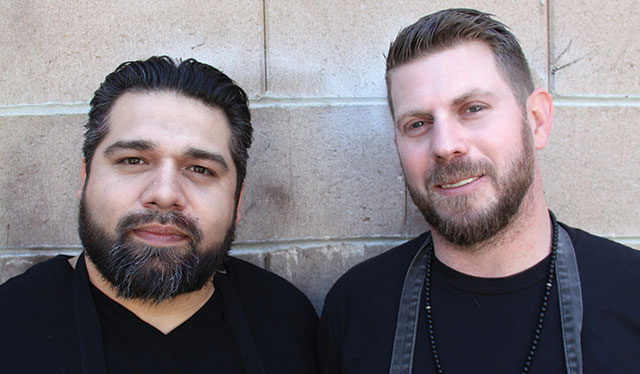
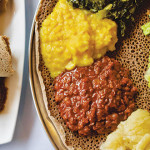 The Grapevine: Openings, expansions and fond farewells in Silicon Valley dining
The Grapevine: Openings, expansions and fond farewells in Silicon Valley dining 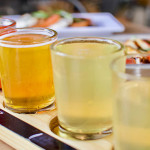 A Pair of Local Cider Entrepreneurs Aim to Elevate the Craft
A Pair of Local Cider Entrepreneurs Aim to Elevate the Craft 